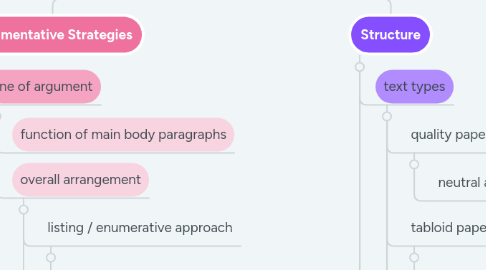
1. Communicative strategies
1.1. use of examples
1.1.1. own experience / biography
1.2. use of facts and dates
1.3. contrast
1.4. judgmental statements
1.5. reader address
1.5.1. direct address ("you")
1.5.2. inclusive "we"
1.5.3. asking questions
1.5.4. call to action
1.5.5. appeal
1.5.6. colloquial style
1.5.7. scientific style
1.6. (reader) involvement
1.6.1. evoking emotions / emotional language
1.6.2. addressing (marginal) groups / parties / institutions
1.6.3. highlighting societal norms / rules / standards
1.6.4. own experience / biography
1.6.5. provoking / challenging the reader
1.7. sarcasm / irony
2. Agrumentative Strategies
2.1. line of argument
2.1.1. function of main body paragraphs
2.1.2. overall arrangement
2.1.2.1. listing / enumerative approach
2.1.2.1.1. presenting a topic and giving opinions on the problem
2.1.2.1.2. arguments --> supporting facts ---> conclusion
2.1.2.2. pro-and-con approach
2.1.2.2.1. presenting a topic and giving opinions on the problem
2.1.2.2.2. arguments --> counter-arguments --> refutation to stress the author's position --> conclision
2.1.3. composition of arguments
2.1.3.1. 1 topic sentence
2.1.3.2. 2 development
2.1.3.3. 3 illustration: support / evidence / data / statistics that show your development is valid --> author's credibility
2.1.3.4. (3.1 refutation)
2.1.3.5. 4 summary / rebuttal
2.2. types of arguments
2.2.1. argument supported by personal experience
2.2.2. argument supported by relevant facts
2.2.3. argument supported by relevant figures
2.2.4. argument by drawing parallels (to other areas of life)
2.2.5. argument based on generally accepted norms, morals, laws, common sense
2.2.6. argument based on the opinion of acknowledged experts or well known people
2.2.7. argument by using real or fictitious / constructed situations to show possible consequences
3. Structure
3.1. text types
3.1.1. quality paper article
3.1.1.1. neutral and informing
3.1.2. tabloid paper article
3.1.2.1. exaggerated manner
3.1.3. feature article
3.1.4. comment or editorial
3.1.5. review
3.1.6. speech
3.2. 1 headline
3.2.1. raising readers interest
3.2.1.1. giving a strong statement / opinion
3.2.1.2. involving the reader
3.2.1.3. creating controversies
3.2.1.4. asking questions
3.2.2. giving a clue of the content / position / opinion of the author
3.3. 1.1 standfirst / subheading
3.3.1. author's claim / first impression of author's attitude
3.3.2. giving additional information
3.4. 2 introduction
3.4.1. stating the thesis / problem / opinion
3.4.2. giving the key facts
3.4.3. giving an outline
3.5. 3 main body
3.5.1. arrangement of main arguments
3.5.2. highlighting own arguments
3.5.3. foreseeing possible arguments / rebutting counter arguments
3.6. 4 conclusion
3.6.1. summing up
3.6.2. linking back to introduction
3.6.3. giving weight to own oppinion
3.6.4. giving an outlook / suggesting a solution
3.6.5. call to action
4. Language
4.1. register (= Sprachebene)
4.1.1. slang, colloquial, everyday English, written language, formal/informal, poetic, sophisticated, familiar, technical terms, scientific, religious
4.2. style
4.2.1. plain, sober, natural, matter-of-fact, clear, precise, concise, vigorous, fluent, colloquial, passionate, elegant, artificial, stilted, wordy, colourless, cliché-ridden, snappy, lengthy, clumsy, spontaneous, trite, expressing doubt/certainty
4.3. tone
4.3.1. humorous, playful, conciliatory, depressive, serious, solemn, ironical, satirical, sarcastic, warm-hearted, aggressive, whining, reproachful
4.4. choice of words
4.4.1. adjectives / adverbs
4.4.2. verbs
4.4.3. nouns
4.4.4. pronouns
4.4.5. positively / negatively connoted nouns / verbs / adjectives / adverbs
4.4.6. denotations, connotations, keywords, figurative/literal meaning of words, emphatic/negative function of words, euphemism, synonyms, abstractions
4.5. sentence structure
4.5.1. simple (subject --> predicate --> object)
4.5.1.1. underlining most important information
4.5.2. complex (main-/subclauses)
4.5.2.1. illustrating complex relations
